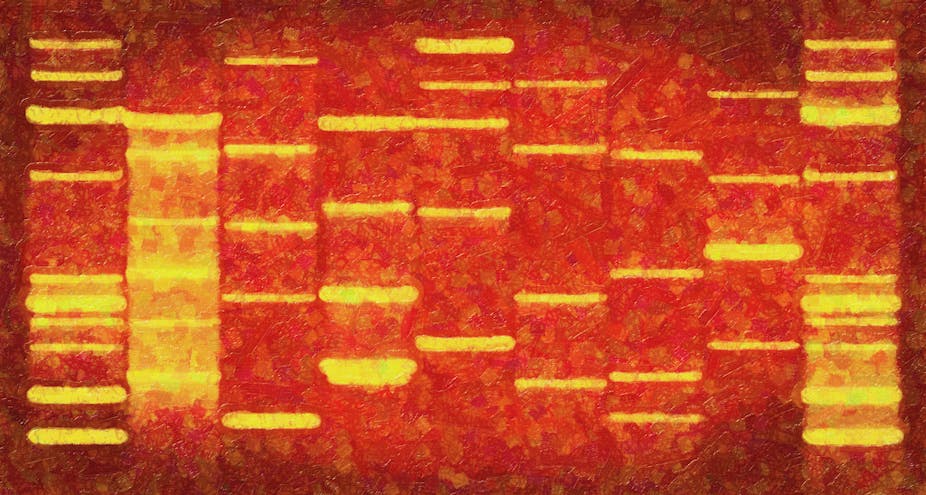I’ve been an ecologist in Australia for the last ten years, working for both government agencies and as a university researcher. Over this time, funding for fieldwork has been increasingly hard to secure, so I recently decided I needed to add some laboratory experience to my CV.
I was lucky enough to receive a fellowship to come to Germany – where I still am – to learn genetic techniques while working on speciation in boas. Having never been in a laboratory, I was unsure if I would be able to master the apparent complexities of the process.
In total contrast, I found that almost anyone can “do” genetics. Under the guidance of a lab technician, over the course of a week, I turned a series of tiny amounts of animal muscle into their corresponding DNA sequences.
In my research area these sequences can be used to differentiate species, look at movement between populations or predict historic distributions.
Recipe for success

To isolate my sequence I didn’t need to know anything about the animal from which the tissue came; I simply followed a recipe and came up with a result.
The first part of the process, to purify DNA, is deceptively simple and, without going into too much detail, occurred like this for me:
1) Mix your sample with protein and buffer; heat overnight until the sample has dissolved.
2) Place the now-clear liquid in a centrifuge and spin to separate the solids and liquid. Decant the liquid into a new test tube and throw the initial one containing any solids away.
3) Add salt to the liquid and centrifuge again. Decant the liquid into a new test tube and throw the old one containing any solids away.
4) Add Isopropanol to the liquid and centrifuge again. This time you discard the liquid and keep the (apparently empty) test tube.
5) Add ethanol to the test tube and centrifuge. Discard liquid.
6) Add ethanol to the test tube and centrifuge. Remove ethanol completely by leaving the open test tubes upside down on paper towel for five minutes, then heat to 37ºC for 20 minutes with the lids open to evaporate.
7) Add sterile water and leave overnight at room temperature, then store in -80ºC freezer until needed.
The process to transform purified DNA into a DNA sequence involves many more steps, but none are particularly hard nor require any great skill beyond that needed to follow any other recipe.

Having said that, over the next month the quality of my sequences diminished in proportion to the amount of supervision I was receiving from the laboratory technician. Finally I was not able to retrieve any DNA sequence from the initial sample.
Clearly, just following the recipe was not enough. We trouble-shot in all the logical ways: re-running the process, replacing old re-agents and changing re-agent concentrations.
When this didn’t work we moved from science to superstition.
I used different machines because another professor in the research group suggested “that type of DNA works well in that machine”.
Other superstitions I heard included:
- never work on Fridays because “that’s a bad day for DNA”
- use white gloves to purify DNA and blue gloves for everything else
Never was it suggested that my technique was bad (I’m sure it was) or that there may not have been any DNA in the samples.
The process of turning a tissue sample into DNA (extraction, amplification and sequencing) and the troubleshooting methods (changing re-agents, machines, gloves) seemed perfectly natural and acceptable to everyone else, but to me they were deeply disturbing.
As an ecologist I had always viewed genetics as rigorous and precise, yet my experience was the opposite: there were huge, and seemingly random, differences in the precision required at each step, significant opportunities for contamination and no feedback that any step was successful.

While I don’t doubt the validity of research using genetics, the magic of turning a tissue sample into a sequence seems to have both blinded us to the inconsistencies within the process and charmed us into believing the value of the results unquestioningly.
For instance, when morphological characters and genetics show conflicting results for species phylogenies – the supposed evolutionary relationship between species – the genetics results are often more trusted.
Technological advances in computing power and sample processing speed mean that each year we can process more samples and faster, using more complex analyses.
Yet we rarely step back to assess whether these advances shed any greater light on the world. The process and methodology has become something of an addiction.
I can see how this addiction takes hold: once you have the sample it’s relatively quick and simple (albeit expensive - between A$20-A$100 per sample) to process and analyse. Needless to say, if your project is well-planned it can be completed more quickly.
With more publications than field-based work, laboratory work is a highly attractive career option – not least because it’s seen as “appealing” by funding agencies.
Organism? What organism?
As an ecologist, I was disturbed by how absent the organism had become in many genetic studies.
For the three boa species whose tissue I was sequencing, we know almost nothing of their biology or ecology: how long they live, how many offspring they have or even an estimate of their population size.
Understanding another species and getting this knowledge requires long periods in the field, often over multiple years, and uses fairly standard data collection and analysis techniques which result in only a few papers.
Even if biologists wanted to do this kind of research, funding is rarely available and the limited potential output makes this an unattractive career path.
That was the problem I faced, which is why I ended up in a laboratory getting to know chemicals, test tubes and different-coloured gloves rather than in the field getting to know an organism in its environment.
I’m sure many others have been, and will continue to be, in the same unfortunate position.

